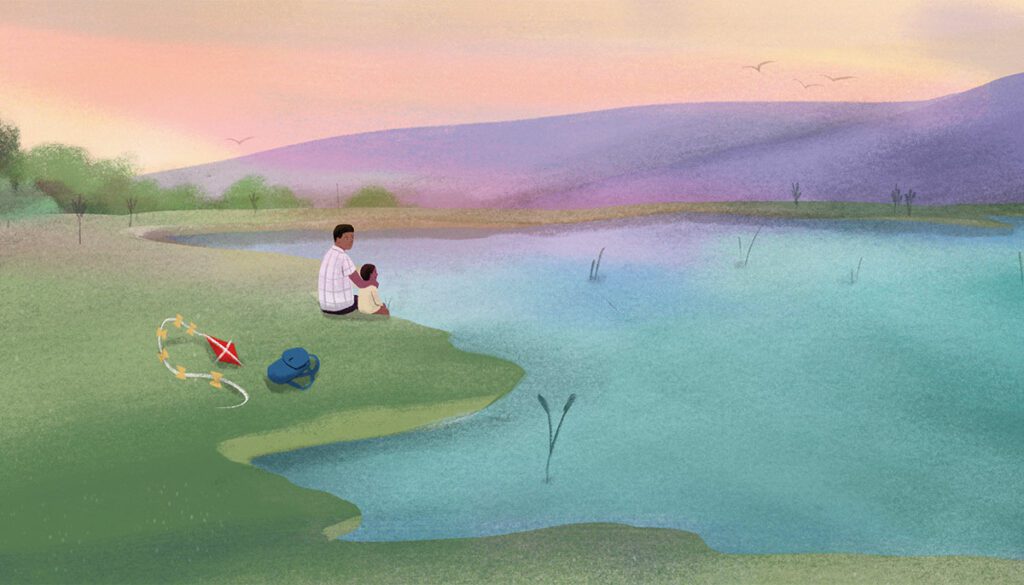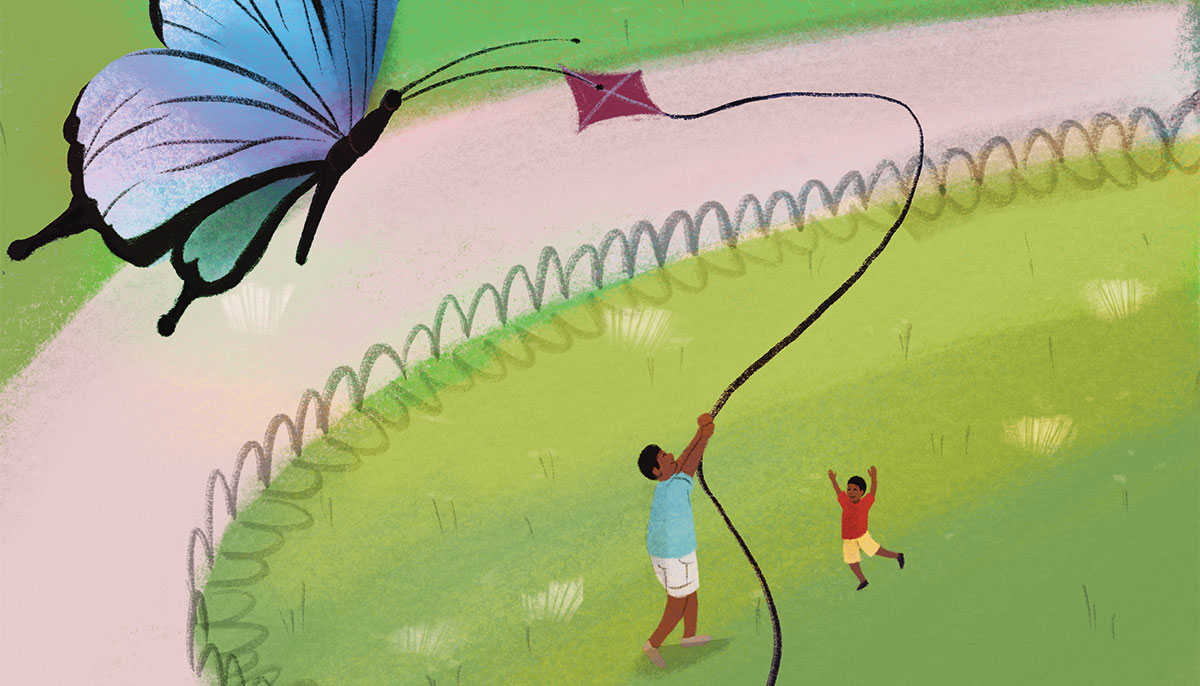I accepted an invitation to sit in my grandfather’s armchair. Big, blue, and like most things in the seventies, the chair was covered in scratchy fabric, but I didn’t care. I was nine, and with my legs folded into a pretzel shape, I was only thinking about my Pop-Pop. He was in the less comfortable chair across from me, smiling as we played checkers. Candy seemed to sprout from his shirt pocket, and I peeled away the sapphire wrappers, working my way through roll after roll of peppermint Lifesavers.
There was no reason to think this would be the last time I’d see my grandfather. But a few weeks later, I was at summer camp when I was pulled from the evening activity to meet my brother by the mess hall. “Pop-Pop died,” he told me. He’d had a heart attack, and we were going home for the funeral. I was gutted and stunned. I didn’t know what to say or do. I’d never felt that feeling before, the kind that loss leaves.
At home I did my best to go with the flow. My parents were understandably busy and didn’t have time (or maybe the ability) for conversations that would outlast an enveloping hug or an instruction as to what I was to wear to the funeral.
Reflecting on my last visit with my grandfather is my favorite way of remembering him, but a few years ago I thought about it for a different reason: my father had become terminally ill, and I was considering how to prepare my children for his imminent passing.
Sitting at my father’s bedside with my brother, I observed my father sleep. I watched the curious movements of his hands and mouth, the rhythm of his breath, and with delight, I saw my grandfather’s continuation in him—in the tone of his skin and in his hair, still lustrous and full.
“Remember when Pop-Pop died?” I finally said to my brother. Then I told him how stunned I’d been by the loss, assuming he’d felt the same. I’d no idea that his next words would stun me all over again.
“That wasn’t his first heart attack,” he said. “Pop-Pop had a bad heart for a while.” My brother said it casually, as if “prior surgeries” and “hospitalizations” were a matter of public record. But nobody had wanted me to know!
“I guess we were trying to protect you,” my brother said.
Protect me from what? I thought.
Understandably, most grown-ups aren’t lining up to discuss death with children. The idea of such a conversation might seem as insufferable as loss itself. But Buddhism tells us that suffering is part of life. To ease suffering, we need to understand and make peace with impermanence. Everything is impermanent, even the nature of the pain we feel when we lose a loved one.

As we think about how to engage our children in conversations about grief and loss, we’ll first want to make sure we are on board with the idea of including them. We might wonder, as I imagine my parents did, is it harmful for children to experience suffering, bear witness to their parents’ vulnerability, or discover that their trusted grown-ups don’t have all the answers? It may depend upon the nature of the child, but as a general rule, in letting children behind the curtain, we not only give them the opportunity to become part of a ritual, we provide a model for self-expression and for the provision of compassionate care.
When deciding what to share, we can use mindful awareness to balance everyone’s needs—our own, our child’s, and that of the dying individual. Beginning with yourself, can you come into awareness of your thoughts as well as their underlying intention? If you’re choosing not to share certain information, is it because it will be too hard for you, or is it because the nature or age of the child suggests that it might be too challenging for them? Consider inviting your child to participate in a conversation about how involved they’d like to be. Keep in mind that some children, despite their age, may wish to keep conversations brief while others may be expressive and manifest a natural curiosity. Next, what about the mindset of the one who’s transitioning? What’s their wish as it relates to young visitors? Their desires, along with the nature of their relationship to the child, are worthy considerations.
When preparing your child for a visit, you’ll naturally tell them what they can expect, but they may also want to know how to be present with someone who’s dying. Drawing upon your unique understanding of your child, provide suggestions that align with their persona and capabilities. For example, you might let them know it’s okay to hold their loved one’s hand, to watch the rise and fall of their breath, and to see if they can breathe along with them. If something more active is called for, you might suggest they tell (or read) a story or sing or play a song. Suggest words of love, demonstrate how quietly (or loudly) they should talk, and let them know you’ll be by their side to help.
One of my nephews appeared regularly at my father’s bedside bearing a dimpled grin. His visits were full of crayon curations and kisses, while his more reticent brother sent love quietly from across the room. My teenagers each found a way of being present that was unique to their relationship with their grandfather. One talked about baseball, specifically, how the Phillies were doing. Another (with a knack for songwriting) wrote a song, and when our youngest said she didn’t know how to be or what to do, we sat silently together, holding my father’s hands, being with him in the simplest way. What’s most important is to recognize each child’s way as their own and to support them in their journey.
At some point, your child might express their grief, and you might wonder what guidance Buddhist wisdom can provide. Drawing on the concepts of interbeing (the interconnectedness of all things and beings) and continuation (the perpetuation of one’s presence), we can help children take care of their sadness. Though these concepts are straightforward, we want to ensure we have a hold on them before we discuss them with our little ones. The relationship between interbeing and continuation might be described like this: because we inter-are with the universe (molecularly, experientially, and genetically), we continue in the people and places around us, even after our physical body is no longer present.
We can ease into this conversation in a child-friendly way by sharing a personal example of how a loved one continues in us and then encouraging our child to do the same. Maybe you excel at a certain skill or craft because you inherited the talent from a parent or grandparent, or perhaps you see your dearly departed in the mirror, in the shape of your smile or the warmth in your eyes. Has something they shared with you shaped who you are and how you do things? Looking no further than oneself to experience the presence of our loved ones won’t erase our sadness, but these moments of mindful awareness provide an opportunity to feel closer to those who have passed on, thereby easing our woes.
Finally, invite your child to decide how they might like to memorialize or celebrate their loved one. If the child and their loved one flew kites together in the spring or baked pies in the fall, you might suggest these activities continue and be passed along through the generations. My father had an evening ritual of eating ice cream from the carton. He’d scrape the layers with the precision of a Zamboni resurfacing a rink. Nowadays, I eat ice cream in this way too, much to the chagrin of my family.
With my father, we knew the end was near, and we were able to use the time we had well. He welcomed young visitors, which enabled the family to participate collectively in his passage. A highlight for all of us was a New Year’s Eve celebration in which we each raised a glass and shared something we’d learned from him, something indelible that would continue.
After we finished, my father held his glass in the air. “Now it’s my turn,” he said. “I get to tell you what I learned from all of you.” Everyone was silent as he paused: “I learned how to love,” he said, “and I thank all of you for giving that gift to me.”
Now, every year, on the cusp of the new one, I think of my father and the gifts he gave, and in so doing, I continue a story that is—always—to be continued.
This article is from the March 2024 issue of Lion’s Roar magazine.

